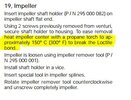Themist456
Member
Hello everyone,
Was causing in my 96 xp last weekend and jet pump siezed up on me. I have an extra jet pump but would like to get the impeller out of this one because it's pretty much a brand new Solas. However, I have tried everything I can to get it off and can not.
I had a 4 inch vise that I actually broke because of how tight it is om the threads.
Got a 5 inch to replace it now.
I have let it sit with wd-40 over night and used a cheater pipe breaker bar. Still nothing.
I cannot get the vise to clamp hard enough on the shaft and its keeps slipping once I put some torque into it.
Any other suggestions? At this point I might just take it to the dealer as this is my personal seadoo and I am missing it.
Was causing in my 96 xp last weekend and jet pump siezed up on me. I have an extra jet pump but would like to get the impeller out of this one because it's pretty much a brand new Solas. However, I have tried everything I can to get it off and can not.
I had a 4 inch vise that I actually broke because of how tight it is om the threads.
Got a 5 inch to replace it now.
I have let it sit with wd-40 over night and used a cheater pipe breaker bar. Still nothing.
I cannot get the vise to clamp hard enough on the shaft and its keeps slipping once I put some torque into it.
Any other suggestions? At this point I might just take it to the dealer as this is my personal seadoo and I am missing it.







